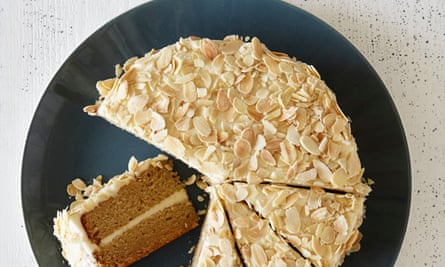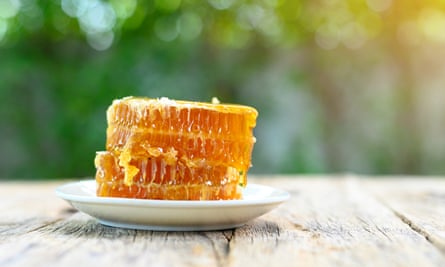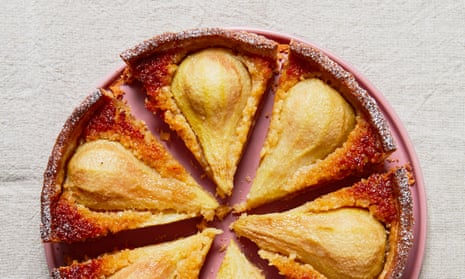Honey comes in many forms: runny, set, wild, farmed, raw, processed. It can be filtered simply – to remove bits of wax and the odd bee leg – or more aggressively, so the end product is flawlessly clear. Monofloral types, from hives that pollinate a particular sort of plant, such as acacia, manuka and sage, can command high prices. Honeydew honey, which bees harvest not from melon flowers but from the sticky secretions of aphids, is a harder sell.
The ways in which honey can be used in the kitchen are almost as varied, but we will struggle to limit ourselves to 17.
Some people say you should never cook honey, as the high heat destroys any health benefits, or even turns the honey toxic. The latter claim, at least, is untrue. As for health-giving properties, bear in mind that in spite of all its antioxidants, honey is really no better for you than cane sugar, because honey essentially is sugar – a combination of fructose and glucose – although recent studies have indicated that it is more effective than some medicines in treating coughs and colds. It’s also worth remembering that the complex aromatic profile of a fine single-estate honey won’t survive much heating, so don’t spend too much money on a honey you’re going to cook with.

We start with Mary Berry’s easy honey and almond cake, in which all the ingredients are beaten together. You can use an electric mixer or do it by hand if you’re fond of exercise. This sticky honey cake from a Guardian reader adds brandy.
Tom Hunt has a cake recipe to make use of old honey that has crystallised, although to return honey to it liquid state, just stand the jar in hot water on a low heat. But if you’re heating up water, you’re already cooking, so you might as well get some cake out of it.
You can use honey instead of sugar for most kinds of baking, though honey is sweeter, so you’ll require less of it – about 25% less by weight. You’ll also need to reduce the overall liquid content of the recipe by about a fifth, and possibly add a pinch of baking powder to counteract honey’s natural acidity. And here’s a tip for measuring out small amounts of honey: if you oil the teaspoon first, it slides right off. Otherwise you’ll be waiting around all day.
Tamal Ray’s honey pear tart uses set honey for the filling, combined with butter, breadcrumb and an egg, into which three peeled and halved pears are placed. You may need to size your fruit judiciously to make this visually pleasing, but the taste will work no matter what – it’s basically a treacle tart with pears in. What’s not to like?
A lot of pudding recipes include honeycomb, but honeycomb can refer to two very different things: raw honey still in its wax comb; or a candy otherwise known as cinder toffee or hokey pokey (think the middle of a Crunchie bar) which normally contains no honey. This honeycomb cake calls for the former and this salted honey fudge tart the latter. The potential for confusion is high, but it’s hard to imagine either recipe being severely harmed by a mix-up. It is also possible to make the cinder toffee-type honeycomb using actual honey, as this recipe from The Loopy Whisk shows.

Honey and star anise panna cotta has only a few ingredients beyond the two in the title: double cream, gelatine, milk and the seeds from a vanilla pod. Jeremy Lee’s honey ice-cream is just as simple, unless you don’t have an ice-cream machine, in which case you’ll need to whisk the mixture by hand every 10 minutes while it freezes.
A honey and yoghurt set cheesecake from Yotam Ottolenghi requires no baking – just yoghurt, thickened by straining it through a tea towel, whisked with cream cheese, icing sugar, lemon zest and melted white chocolate, poured on to a biscuit base. The honey, warmed up with some thyme leaves, goes on at the end.
As sweet as it is, honey has its uses in all kinds of savoury dishes. It’s a key ingredient in many barbecue marinades, including this one, because it’s sticky – it helps the sauce adhere to the food. This is also the case with Anna Jones’s smokey honeyed cauliflower steaks and this recipe for honey and orange sea bass, in which the fillets are drizzled with a mixture of honey, mustard and orange zest before being roasted in foil parcels.

Many recipes will tell you to take extra care when heating honey because it burns easily, turning dark and bitter. As a cook who often finds himself on the wrong side of golden brown, even when making toast, I’m always pleased by recipes that tell you to burn things on purpose. Ottolenghi’s butternut squash with orange oil and burnt honey is one such dish: the honey is left to boil for two or three minutes until deeply coloured, then mixed with orange juice and vinegar, poured over baked squash and pecorino and served with the words, “Yeah, it’s supposed to to look like that, actually”.

As inspirational snacks go, you could do worse than Liam Charles’s honey caramel popcorn, which he claims was invented by accident during a cinema-going mishap, when someone’s honey roasted nuts were tipped into his caramel popcorn. It’s hard to imagine a collision involving ice-cream and nachos ending so serendipitously, but perhaps I’m thinking inside the box again.
Finally, if you’ve got nothing but honey and time on your hands, you could try making mead. On its own, honey is too high in sugar to allow fermentation – that’s why it keeps for ever. But once it’s diluted with warm water and left to brew, the natural yeasts within the honey get to work. This recipe produces two kinds of mead: a fizzy soft drink, which only takes about a week, and a longer fermenting, alcoholic version that is suitable for short stretches in prison, or a suddenly extended lockdown spell. Enjoy.
